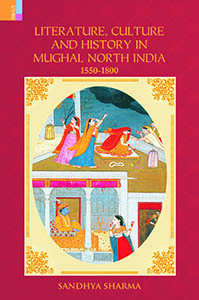
Literature, Culture and History in Mughal North India, 1550-1800
AUTHOR- Sandhya Sharma
| HB ₹1195 . $79.95 . ₤52.95 |
PB ₹725 . $44.95 . ₤36.95 |
|
INFORMATION
- AUTHOR : Sandhya Sharma
- HB ISBN : 978-81-908918-1-3
- PB ISBN : 978-93-86552-72-3
- HB Year : 2011, PB Year : 2018
- Extent : x + 232 pp.
- Discount available on checkout
- Usually dispatched within 3 to 5 working days.
Literature, Culture and History in Mughal North India, 1550-1800
| HB ₹ 1195 . $ . ₤ |
||
INFORMATION
- AUTHOR – Sandhya Sharma
- ISBN – 978-81-908918-1-3
- Year – 2010
- Extent: 400 + 40 coloured illustrations
- 10% discount + free shipping
- Usually dispatched within 3 to 5 working days.
This book is a pioneering attempt to study Mughal Indian polity and the dynamics of family, kinship and caste through Riti Kal literature. The literature, in the form of drama and Braja bhasha poetry, provides evidence of regional diversities and varied patterns of historical developments in medieval north India as well as a dynamism in the political and socio-cultural spheres in premodern India. A detailed analysis of Riti Kal poetry reveals that the regions, in spite of conflicts and contestations for power, did acknowledge the Mughals as the undisputed rulers of Hind, the future India.
Riti Kal poetry provides enough evidence to highlight the transformation that had begun to take place in the traditional forms of relations during this period. While the poets continued to advocate the conventional role of women in family and society they also depicted, with sympathy and understanding, the individuality, liberty and sexuality of the fairer sex. The legends of Krishna and Radha, expressed through the tradition of the nayak and nayika in Braja poetry, give voice to not only the age-old myths attached to these characters but also newer representations in line with contemporary religious traditions.
Literature, Culture and History in Mughal North India (1550-1800) is a path-breaking work in that it departs from the popular norm of viewing history mainly through Persian historiography. It is the first detailed study of the so-called vernaculars—in this case the Braja poetry, as source material, so far neglected by both, the literati and the historians, in the context of Mughal north India.
The Author
Sandhya Sharma teaches history in one of the colleges of the University of Delhi.
‘The book can also be placed alongside, and in counterpoint to, scholarship on the changing tenor of Indo-Persian aesthetic cultures in the Mughal period (as in the work of Sunil Sharma and Muzaffar Alam). Sharma’s study is an indispensable contribution, pointing to new and revelatory considerations of a highly formalized literature vitally engaged in history.’— SUTOPA DASGUPTA, Harvard University
The Journal of Asian Studies
‘Sandhya Sharma’s work captures an intense cultural moment and documents the social and cultural history of that moment using poetry as evidence. In this effort, she steers away from the mainstream ideas . . . [and] unambiguously provides sufficient ground for her innovative research methodology… a fine balance between materials and analysis constitutes the real strength of this work.’— AFSAR MOHAMMED
University of Texas in Itinerario (Cambridge Journals)
This book is a pioneering attempt to study Mughal Indian polity and the dynamics of family, kinship and caste through Riti Kal literature. The literature, in the form of drama and Braja bhasha poetry, provides evidence of regional diversities and varied patterns of historical developments in medieval north India as well as a dynamism in the political and socio-cultural spheres in premodern India. A detailed analysis of Riti Kal poetry reveals that the regions, in spite of conflicts and contestations for power, did acknowledge the Mughals as the undisputed rulers of Hind, the future India.
Riti Kal poetry provides enough evidence to highlight the transformation that had begun to take place in the traditional forms of relations during this period. While the poets continued to advocate the conventional role of women in family and society they also depicted, with sympathy and understanding, the individuality, liberty and sexuality of the fairer sex. The legends of Krishna and Radha, expressed through the tradition of the nayak and nayika in Braja poetry, give voice to not only the age-old myths attached to these characters but also newer representations in line with contemporary religious traditions.
Literature, Culture and History in Mughal North India (1550-1800) is a path-breaking work in that it departs from the popular norm of viewing history mainly through Persian historiography. It is the first detailed study of the so-called vernaculars—in this case the Braja poetry, as source material, so far neglected by both, the literati and the historians, in the context of Mughal north India.
The Author
Sandhya Sharma teaches history in one of the colleges of the University of Delhi.
‘The book can also be placed alongside, and in counterpoint to, scholarship on the changing tenor of Indo-Persian aesthetic cultures in the Mughal period (as in the work of Sunil Sharma and Muzaffar Alam). Sharma’s study is an indispensable contribution, pointing to new and revelatory considerations of a highly formalized literature vitally engaged in history.’— SUTOPA DASGUPTA, Harvard University
The Journal of Asian Studies
‘Sandhya Sharma’s work captures an intense cultural moment and documents the social and cultural history of that moment using poetry as evidence. In this effort, she steers away from the mainstream ideas . . . [and] unambiguously provides sufficient ground for her innovative research methodology… a fine balance between materials and analysis constitutes the real strength of this work.’— AFSAR MOHAMMED
University of Texas in Itinerario (Cambridge Journals)




